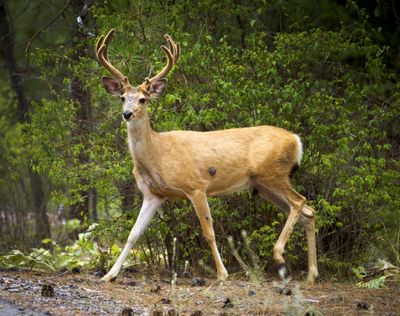Study: Wolves push mule deer higher, don’t impact whitetail

Wildlife photographers and hunters looking for mule deer may need to hike a little higher.
Wolves in Northeast Washington have pushed mule deer into rockier, higher ground, according to a University of Washington study published in December.
At the same time, white-tailed deer don’t appear to be shifting their habitats, according to the study published in the journal Oecologia.
“(Mule deer) are sort of picking up and wholesale using different types of country,” lead author Justin Dellinger said in an interview. “More rough and rugged country to sort of just avoid wolves. The whitetail deer they weren’t using completely different areas … but it’s almost like the white tail deer were trying to position themselves to detect wolves early in an encounter to give them a chance of escaping predation.”
Dellinger, who works with mountain lions and wolves in California, studied the movements of white-tailed and mule deer for three years near Republic, Washington, while he was a PhD student at the University of Washington.
The difference in avoidance behavior came down to the ways the deer flee from predators, Dellinger said.
Mule deer, which leap high into the air, favored rougher uneven terrain, which generally led them to higher elevations. White-tailed deer, which sprint from predators, looked for more open terrain and roads where they were often able to outrun the wolves.
The study is one look at how the return of wolves has changed Washington’s ecology.
Unlike Yellowstone or other areas where wolves have returned in force, Northeast Washington is heavily impacted by humans.
“It’s fascinating to think about in 2019, you have a landscape that is regaining its full sweep of predators,” he said. “It’s really remarkable that such a place exists outside of a national park in the Lower 48.”
The deer habitat study builds on work Dellinger has already done looking at deer mortality and wolves. That study was published in 2018 and had counterintuitive results.
Essentially, Dellinger said, wolves “had little or no impact on the deer from a survival standpoint.”
For many, this doesn’t make sense. It would seem that adding a predator to a landscape would only increase mortality. That’s not what he found. Instead, overall deer mortality stayed about the same despite the return of wolves.
“It was a reshuffling of the deck as far as source of mortality.” he said. “But overall survival didn’t change a whole lot.”
The mortality study and the deer movement study support the idea that human activity plays a much bigger role on wildlife health and populations than predators, Dellinger said.
The larger question of both studies is whether natural processes can still play out even in the shadow of heavy human presence.
Other studies, including the Washington Department of Fish and Wildlife’s ongoing predator-prey study, will shed more light on the question.
Dellinger’s most recent habitat study was funded by Conservation Northwest, the Washington Department of Fish and Game, Safari Club International Foundation and the National Science Foundation.
For some hunters, the studies’ findings don’t align with what they see in the field.
Al Martz has lived and hunted in the Chewelah area for 40 years and is the co-chairman of the NE WA Wildlife Group.
He agrees that area hunters have seen a shift in where deer are spending their time since the return of wolves. While mule deer may be moving higher, it also seems that white-tailed deer are congregating in the valleys.
“You can’t hardly find a (white-tailed) deer above 3,000 feet or 3,500 feet,” he said.
He blames that on increased wolf and cougar predation.